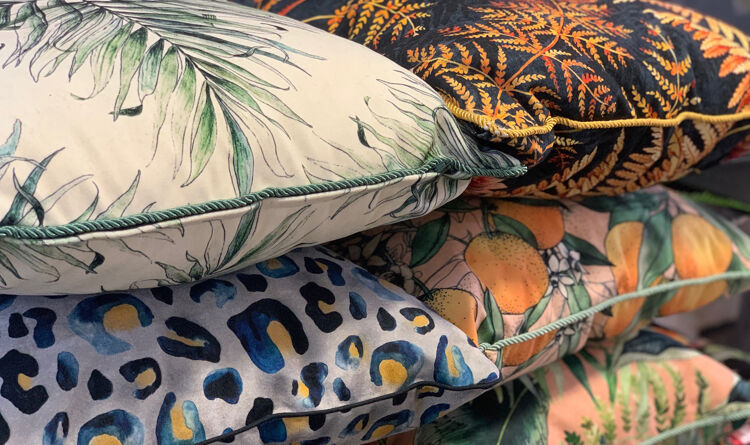Supply Chain Disruption and Fabric Sourcing for Digital Textile Printers

Today, in a world where textile supply chains are constantly disrupted, the secure sourcing of fabrics at reasonable prices has become a significant challenge for most digital textile printers.
Just this month the Office for National Statistics, as it reported a doubling in the UK inflation rate also cited supply chain disruption for textiles as the main reason that clothing and footwear prices rose by 2.4% in a month.
Pandemic disruption has broken established supply chains for finished goods and forced buyers to look nearer to home for certainty of supply.
The re-shoring of textile print production has become an opportunity for the digital textile industry to grow, playing to the strengths of the industry - speed to market and minimal stock exposure. This can be seen in the current boom in online digital textile offerings, where companies such as Spoonflower and Printful have registered seismic growth.

Yet, increased demand has created a new set of challenges for printers trying to secure fabric from a disrupted supply chain in the midst of a global pandemic - which has heavily impacted the availability of core products. The digital printer, faced with these challenges, now has to take a long hard look to their own supply chains and look to source new vendors.
In a global fabrics market that is expected to grow from $165.7 billion in 2020 to $228.6 billion in 2025 at a compound annual growth rate of 6% (The Business Research Company), the choices for the digital textile printer may seem endless. And yet, in practical terms, for the majority of digital textile print businesses, they remain small players in a vast marketplace. Volume dictates that they are price takers and not price setters.

For although the digital textile print market is predicted to grow to $8.8 billion by 2027 (Allied Market Research), the simple truth is that it still only uses less than 4% of total global fabric production, and, as a result, the digital print industry is not yet able to commandeer the weight of purchasing power held by long established volume textile producers.
For example, a standard container of textile fabric will contain over 30,000 metres of fabric, an amount that is simply beyond the reach of most producers in this fledgling industry. Add on to that the need for fabrics to be coated prior to use, and the direct importation of fabric becomes an operation that is not only costly in terms of working capital, but also quite complicated technically. It is because of these factors, that lead times are affected, and in the long run become similar to the lead time for finished goods.
Additionally, the disruption of supply chains has also threatened the continuity of fabric quality, in an industry where fluctuations in preparation standards can cause unwanted variations in colour gamut and vibrancy.
To secure reliable fabric supplies, the medium sized digital textile printer has been forced to hold a much larger fabric stock than previously. They have also had to look to substantial international fabric distributors to support them and maintain the crucial quality and supply equation so vital in digital textile printing.
The digital textile industry is underpinned by a network of fabric suppliers and distributors, many of whom serve the traditional textile sector, thus allowing them to buy large stocks and to segregate these for digital production (PFDP). Its these combined stock holdings and a solid - international supply chain - with reliable technical expertise, that ensure the continuity of supply for many digital textile printers, who rely on their sourcing expertise and networks whilst also invigilating the fabric importation process.
In the UK, CMYUK, Soyang, Ambassador, Premier Textiles, Edmund Bell and Camira are amongst the major volume players. Whilst in Europe Texo Trade Services, Berger textiles, Libeco, Pongs and Colgraphix all have well-oiled international supply chains at their disposal.
No doubt as the effects of the pandemic ease, the current supply conundrum will unwind, and supplies will become readily available again, but for the time being all digital printers must look seriously at their supply chain to ensure that they are not caught out, either on price or delivery, by the present covid-driven difficulties.
Discover the latest innovations in digital textile printing at the Global Print Expo 2021, Europe's leading exhibition for screen and digital wide format print, textile printing and signage. Discover the latest products, network with like-minded individuals and explore new business opportunites. Register now and use promo code FESH101 to receive a discount of 30 euros.
Topics
Interested in joining our community?
Enquire today about joining your local FESPA Association or FESPA Direct
Recent news

The importance of ink for large format printers
Ink is crucial for large format inkjet printers, influencing substrate compatibility, productivity, and cost. Nessan Cleary discusses the three main types which include UV-curable ink, latex ink and eco-solvent ink. Each ink type has specific strengths and weaknesses, making printers choice dependent on budget and intended applications.

What are the benefits of Direct-To-Fabric printing?
Direct-to-fabric printing is gaining popularity for high-volume textile production, enabling on-demand, customized short runs. These printers offer ink flexibility, accommodating various fabric types like cotton and silk, though ink development focuses on faster turnaround by reducing pre- and post-processing. Compared to traditional methods, direct-to-fabric inkjet printing is a more sustainable option due to reduced water and chemical usage, and localized production.

What are the opportunities for large format providers regarding digital touch screens?
Digital touchscreens are becoming increasingly common, offering businesses opportunities to improve customer engagement and streamline operations. Nessan Cleary shares, while more expensive to implement than standard digital displays due to complex software and integration needs, touchscreens provide self-service options, multilingual support, and can reduce staffing costs in various settings like retail, transportation, and healthcare.
